Project 1: Feedback, Forecast, and Examples of Accounting Info
VerifiedAdded on 2023/01/05
|13
|2978
|23
Report
AI Summary
This report analyzes the concepts of 'feedback value' and 'forecast value' in financial decision-making, highlighting their roles in improving user choices based on past performance and future predictions. It explains the significance of accounting relevance and predictive value in financial reporting, supported by an example of customer comments on corporate tax reports. The report then provides four examples of accounting information extracted from an annual report: the balance sheet, income statement, statement of cash flows, and ledger accounts. It details the components and functions of each, including how changes in accounts receivable, inventory value, and cash flows impact financial analysis. The report also covers the indirect and direct methods for calculating cash flow, and the ledger account's role in maintaining financial transaction records. The report emphasizes the interrelation of these elements in providing a comprehensive view of a company's financial health and performance.
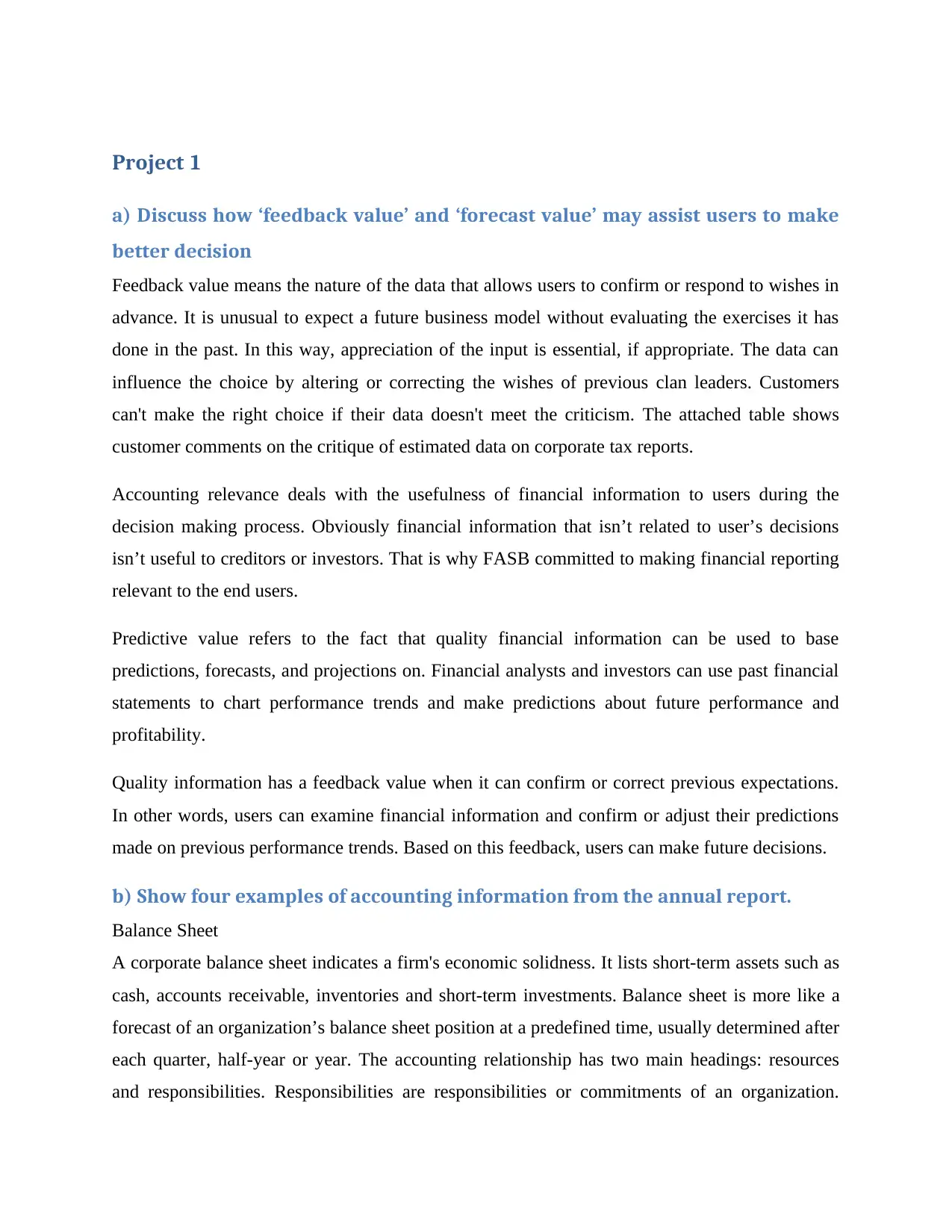
Project 1
a) Discuss how ‘feedback value’ and ‘forecast value’ may assist users to make
better decision
Feedback value means the nature of the data that allows users to confirm or respond to wishes in
advance. It is unusual to expect a future business model without evaluating the exercises it has
done in the past. In this way, appreciation of the input is essential, if appropriate. The data can
influence the choice by altering or correcting the wishes of previous clan leaders. Customers
can't make the right choice if their data doesn't meet the criticism. The attached table shows
customer comments on the critique of estimated data on corporate tax reports.
Accounting relevance deals with the usefulness of financial information to users during the
decision making process. Obviously financial information that isn’t related to user’s decisions
isn’t useful to creditors or investors. That is why FASB committed to making financial reporting
relevant to the end users.
Predictive value refers to the fact that quality financial information can be used to base
predictions, forecasts, and projections on. Financial analysts and investors can use past financial
statements to chart performance trends and make predictions about future performance and
profitability.
Quality information has a feedback value when it can confirm or correct previous expectations.
In other words, users can examine financial information and confirm or adjust their predictions
made on previous performance trends. Based on this feedback, users can make future decisions.
b) Show four examples of accounting information from the annual report.
Balance Sheet
A corporate balance sheet indicates a firm's economic solidness. It lists short-term assets such as
cash, accounts receivable, inventories and short-term investments. Balance sheet is more like a
forecast of an organization’s balance sheet position at a predefined time, usually determined after
each quarter, half-year or year. The accounting relationship has two main headings: resources
and responsibilities. Responsibilities are responsibilities or commitments of an organization.
a) Discuss how ‘feedback value’ and ‘forecast value’ may assist users to make
better decision
Feedback value means the nature of the data that allows users to confirm or respond to wishes in
advance. It is unusual to expect a future business model without evaluating the exercises it has
done in the past. In this way, appreciation of the input is essential, if appropriate. The data can
influence the choice by altering or correcting the wishes of previous clan leaders. Customers
can't make the right choice if their data doesn't meet the criticism. The attached table shows
customer comments on the critique of estimated data on corporate tax reports.
Accounting relevance deals with the usefulness of financial information to users during the
decision making process. Obviously financial information that isn’t related to user’s decisions
isn’t useful to creditors or investors. That is why FASB committed to making financial reporting
relevant to the end users.
Predictive value refers to the fact that quality financial information can be used to base
predictions, forecasts, and projections on. Financial analysts and investors can use past financial
statements to chart performance trends and make predictions about future performance and
profitability.
Quality information has a feedback value when it can confirm or correct previous expectations.
In other words, users can examine financial information and confirm or adjust their predictions
made on previous performance trends. Based on this feedback, users can make future decisions.
b) Show four examples of accounting information from the annual report.
Balance Sheet
A corporate balance sheet indicates a firm's economic solidness. It lists short-term assets such as
cash, accounts receivable, inventories and short-term investments. Balance sheet is more like a
forecast of an organization’s balance sheet position at a predefined time, usually determined after
each quarter, half-year or year. The accounting relationship has two main headings: resources
and responsibilities. Responsibilities are responsibilities or commitments of an organization.
Paraphrase This Document
Need a fresh take? Get an instant paraphrase of this document with our AI Paraphraser
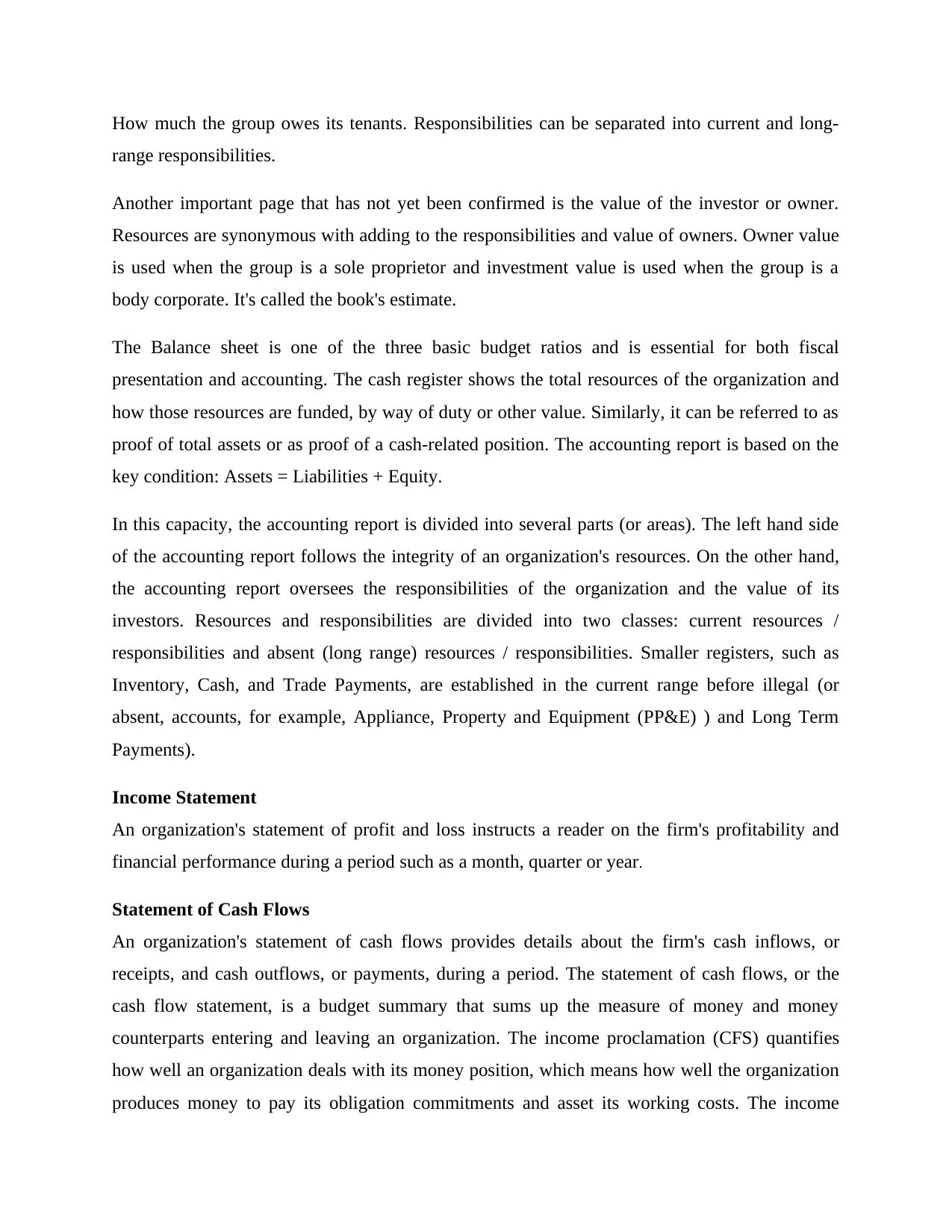
How much the group owes its tenants. Responsibilities can be separated into current and long-
range responsibilities.
Another important page that has not yet been confirmed is the value of the investor or owner.
Resources are synonymous with adding to the responsibilities and value of owners. Owner value
is used when the group is a sole proprietor and investment value is used when the group is a
body corporate. It's called the book's estimate.
The Balance sheet is one of the three basic budget ratios and is essential for both fiscal
presentation and accounting. The cash register shows the total resources of the organization and
how those resources are funded, by way of duty or other value. Similarly, it can be referred to as
proof of total assets or as proof of a cash-related position. The accounting report is based on the
key condition: Assets = Liabilities + Equity.
In this capacity, the accounting report is divided into several parts (or areas). The left hand side
of the accounting report follows the integrity of an organization's resources. On the other hand,
the accounting report oversees the responsibilities of the organization and the value of its
investors. Resources and responsibilities are divided into two classes: current resources /
responsibilities and absent (long range) resources / responsibilities. Smaller registers, such as
Inventory, Cash, and Trade Payments, are established in the current range before illegal (or
absent, accounts, for example, Appliance, Property and Equipment (PP&E) ) and Long Term
Payments).
Income Statement
An organization's statement of profit and loss instructs a reader on the firm's profitability and
financial performance during a period such as a month, quarter or year.
Statement of Cash Flows
An organization's statement of cash flows provides details about the firm's cash inflows, or
receipts, and cash outflows, or payments, during a period. The statement of cash flows, or the
cash flow statement, is a budget summary that sums up the measure of money and money
counterparts entering and leaving an organization. The income proclamation (CFS) quantifies
how well an organization deals with its money position, which means how well the organization
produces money to pay its obligation commitments and asset its working costs. The income
range responsibilities.
Another important page that has not yet been confirmed is the value of the investor or owner.
Resources are synonymous with adding to the responsibilities and value of owners. Owner value
is used when the group is a sole proprietor and investment value is used when the group is a
body corporate. It's called the book's estimate.
The Balance sheet is one of the three basic budget ratios and is essential for both fiscal
presentation and accounting. The cash register shows the total resources of the organization and
how those resources are funded, by way of duty or other value. Similarly, it can be referred to as
proof of total assets or as proof of a cash-related position. The accounting report is based on the
key condition: Assets = Liabilities + Equity.
In this capacity, the accounting report is divided into several parts (or areas). The left hand side
of the accounting report follows the integrity of an organization's resources. On the other hand,
the accounting report oversees the responsibilities of the organization and the value of its
investors. Resources and responsibilities are divided into two classes: current resources /
responsibilities and absent (long range) resources / responsibilities. Smaller registers, such as
Inventory, Cash, and Trade Payments, are established in the current range before illegal (or
absent, accounts, for example, Appliance, Property and Equipment (PP&E) ) and Long Term
Payments).
Income Statement
An organization's statement of profit and loss instructs a reader on the firm's profitability and
financial performance during a period such as a month, quarter or year.
Statement of Cash Flows
An organization's statement of cash flows provides details about the firm's cash inflows, or
receipts, and cash outflows, or payments, during a period. The statement of cash flows, or the
cash flow statement, is a budget summary that sums up the measure of money and money
counterparts entering and leaving an organization. The income proclamation (CFS) quantifies
how well an organization deals with its money position, which means how well the organization
produces money to pay its obligation commitments and asset its working costs. The income
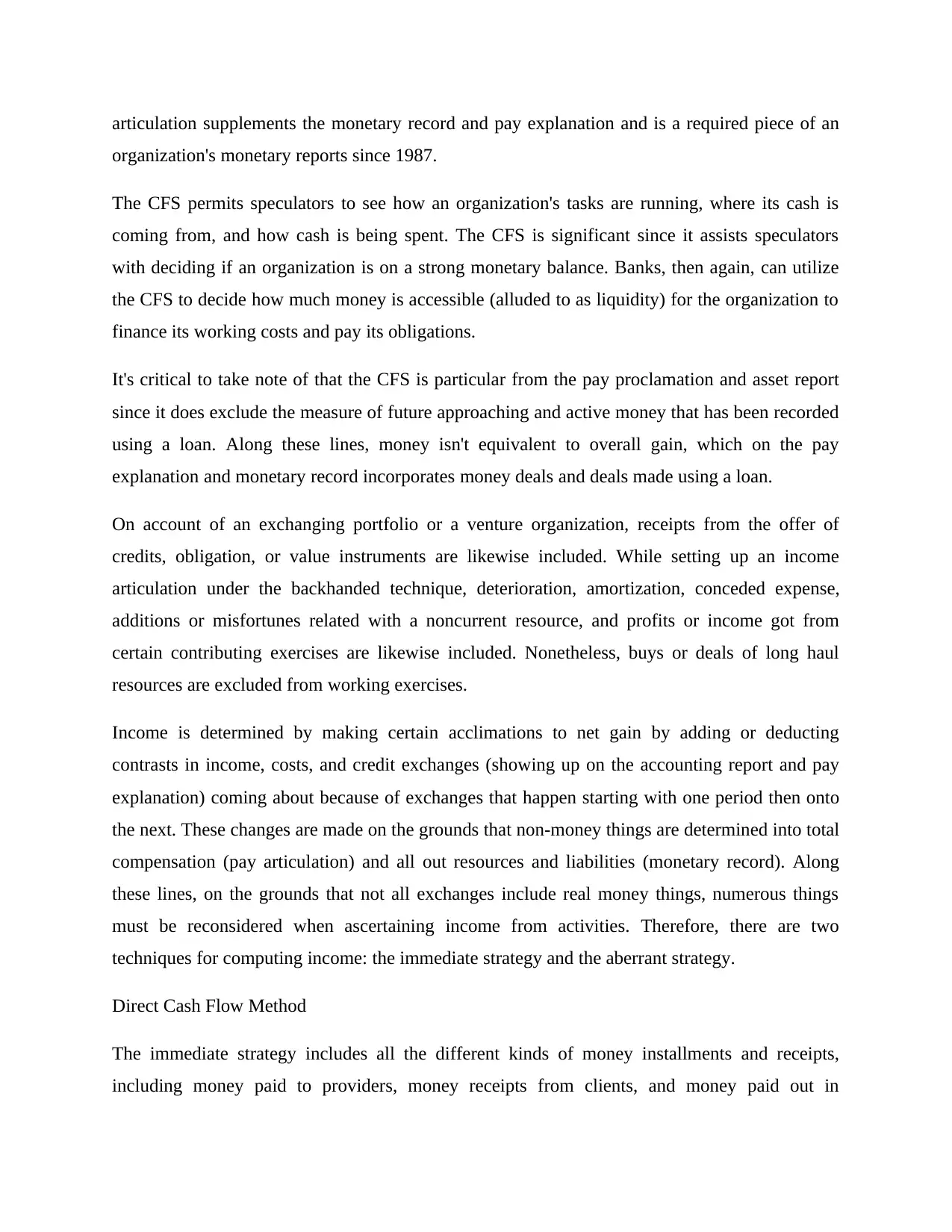
articulation supplements the monetary record and pay explanation and is a required piece of an
organization's monetary reports since 1987.
The CFS permits speculators to see how an organization's tasks are running, where its cash is
coming from, and how cash is being spent. The CFS is significant since it assists speculators
with deciding if an organization is on a strong monetary balance. Banks, then again, can utilize
the CFS to decide how much money is accessible (alluded to as liquidity) for the organization to
finance its working costs and pay its obligations.
It's critical to take note of that the CFS is particular from the pay proclamation and asset report
since it does exclude the measure of future approaching and active money that has been recorded
using a loan. Along these lines, money isn't equivalent to overall gain, which on the pay
explanation and monetary record incorporates money deals and deals made using a loan.
On account of an exchanging portfolio or a venture organization, receipts from the offer of
credits, obligation, or value instruments are likewise included. While setting up an income
articulation under the backhanded technique, deterioration, amortization, conceded expense,
additions or misfortunes related with a noncurrent resource, and profits or income got from
certain contributing exercises are likewise included. Nonetheless, buys or deals of long haul
resources are excluded from working exercises.
Income is determined by making certain acclimations to net gain by adding or deducting
contrasts in income, costs, and credit exchanges (showing up on the accounting report and pay
explanation) coming about because of exchanges that happen starting with one period then onto
the next. These changes are made on the grounds that non-money things are determined into total
compensation (pay articulation) and all out resources and liabilities (monetary record). Along
these lines, on the grounds that not all exchanges include real money things, numerous things
must be reconsidered when ascertaining income from activities. Therefore, there are two
techniques for computing income: the immediate strategy and the aberrant strategy.
Direct Cash Flow Method
The immediate strategy includes all the different kinds of money installments and receipts,
including money paid to providers, money receipts from clients, and money paid out in
organization's monetary reports since 1987.
The CFS permits speculators to see how an organization's tasks are running, where its cash is
coming from, and how cash is being spent. The CFS is significant since it assists speculators
with deciding if an organization is on a strong monetary balance. Banks, then again, can utilize
the CFS to decide how much money is accessible (alluded to as liquidity) for the organization to
finance its working costs and pay its obligations.
It's critical to take note of that the CFS is particular from the pay proclamation and asset report
since it does exclude the measure of future approaching and active money that has been recorded
using a loan. Along these lines, money isn't equivalent to overall gain, which on the pay
explanation and monetary record incorporates money deals and deals made using a loan.
On account of an exchanging portfolio or a venture organization, receipts from the offer of
credits, obligation, or value instruments are likewise included. While setting up an income
articulation under the backhanded technique, deterioration, amortization, conceded expense,
additions or misfortunes related with a noncurrent resource, and profits or income got from
certain contributing exercises are likewise included. Nonetheless, buys or deals of long haul
resources are excluded from working exercises.
Income is determined by making certain acclimations to net gain by adding or deducting
contrasts in income, costs, and credit exchanges (showing up on the accounting report and pay
explanation) coming about because of exchanges that happen starting with one period then onto
the next. These changes are made on the grounds that non-money things are determined into total
compensation (pay articulation) and all out resources and liabilities (monetary record). Along
these lines, on the grounds that not all exchanges include real money things, numerous things
must be reconsidered when ascertaining income from activities. Therefore, there are two
techniques for computing income: the immediate strategy and the aberrant strategy.
Direct Cash Flow Method
The immediate strategy includes all the different kinds of money installments and receipts,
including money paid to providers, money receipts from clients, and money paid out in
⊘ This is a preview!⊘
Do you want full access?
Subscribe today to unlock all pages.

Trusted by 1+ million students worldwide
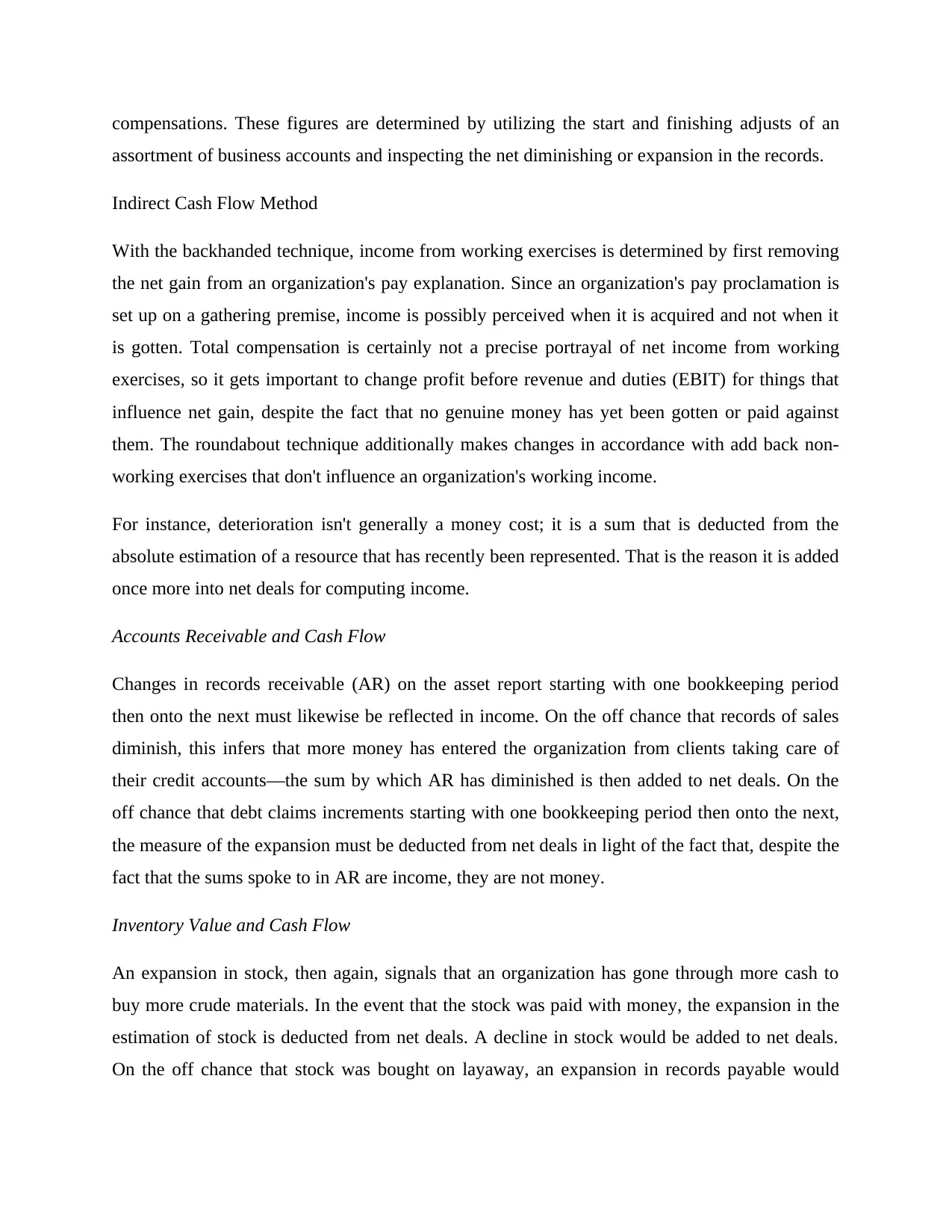
compensations. These figures are determined by utilizing the start and finishing adjusts of an
assortment of business accounts and inspecting the net diminishing or expansion in the records.
Indirect Cash Flow Method
With the backhanded technique, income from working exercises is determined by first removing
the net gain from an organization's pay explanation. Since an organization's pay proclamation is
set up on a gathering premise, income is possibly perceived when it is acquired and not when it
is gotten. Total compensation is certainly not a precise portrayal of net income from working
exercises, so it gets important to change profit before revenue and duties (EBIT) for things that
influence net gain, despite the fact that no genuine money has yet been gotten or paid against
them. The roundabout technique additionally makes changes in accordance with add back non-
working exercises that don't influence an organization's working income.
For instance, deterioration isn't generally a money cost; it is a sum that is deducted from the
absolute estimation of a resource that has recently been represented. That is the reason it is added
once more into net deals for computing income.
Accounts Receivable and Cash Flow
Changes in records receivable (AR) on the asset report starting with one bookkeeping period
then onto the next must likewise be reflected in income. On the off chance that records of sales
diminish, this infers that more money has entered the organization from clients taking care of
their credit accounts—the sum by which AR has diminished is then added to net deals. On the
off chance that debt claims increments starting with one bookkeeping period then onto the next,
the measure of the expansion must be deducted from net deals in light of the fact that, despite the
fact that the sums spoke to in AR are income, they are not money.
Inventory Value and Cash Flow
An expansion in stock, then again, signals that an organization has gone through more cash to
buy more crude materials. In the event that the stock was paid with money, the expansion in the
estimation of stock is deducted from net deals. A decline in stock would be added to net deals.
On the off chance that stock was bought on layaway, an expansion in records payable would
assortment of business accounts and inspecting the net diminishing or expansion in the records.
Indirect Cash Flow Method
With the backhanded technique, income from working exercises is determined by first removing
the net gain from an organization's pay explanation. Since an organization's pay proclamation is
set up on a gathering premise, income is possibly perceived when it is acquired and not when it
is gotten. Total compensation is certainly not a precise portrayal of net income from working
exercises, so it gets important to change profit before revenue and duties (EBIT) for things that
influence net gain, despite the fact that no genuine money has yet been gotten or paid against
them. The roundabout technique additionally makes changes in accordance with add back non-
working exercises that don't influence an organization's working income.
For instance, deterioration isn't generally a money cost; it is a sum that is deducted from the
absolute estimation of a resource that has recently been represented. That is the reason it is added
once more into net deals for computing income.
Accounts Receivable and Cash Flow
Changes in records receivable (AR) on the asset report starting with one bookkeeping period
then onto the next must likewise be reflected in income. On the off chance that records of sales
diminish, this infers that more money has entered the organization from clients taking care of
their credit accounts—the sum by which AR has diminished is then added to net deals. On the
off chance that debt claims increments starting with one bookkeeping period then onto the next,
the measure of the expansion must be deducted from net deals in light of the fact that, despite the
fact that the sums spoke to in AR are income, they are not money.
Inventory Value and Cash Flow
An expansion in stock, then again, signals that an organization has gone through more cash to
buy more crude materials. In the event that the stock was paid with money, the expansion in the
estimation of stock is deducted from net deals. A decline in stock would be added to net deals.
On the off chance that stock was bought on layaway, an expansion in records payable would
Paraphrase This Document
Need a fresh take? Get an instant paraphrase of this document with our AI Paraphraser
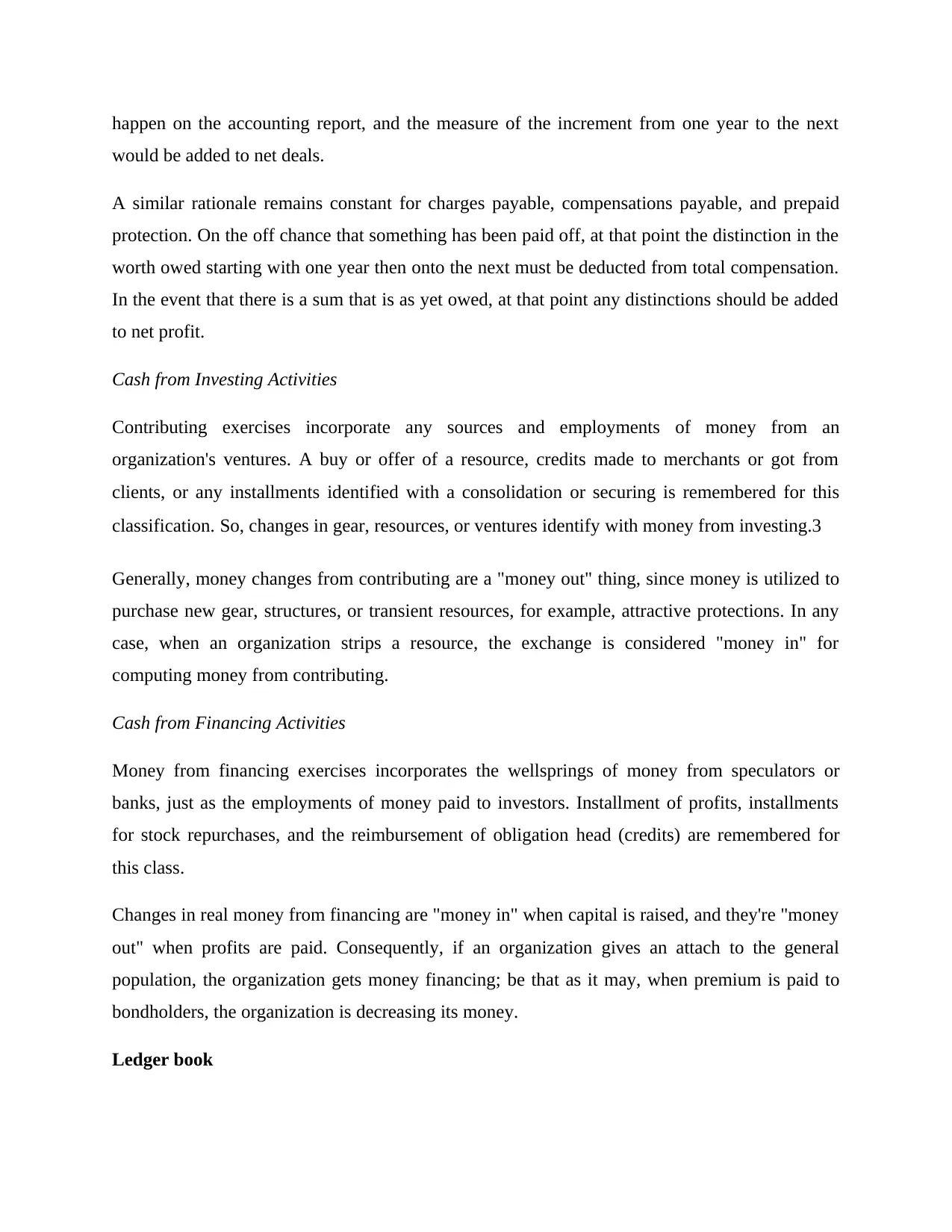
happen on the accounting report, and the measure of the increment from one year to the next
would be added to net deals.
A similar rationale remains constant for charges payable, compensations payable, and prepaid
protection. On the off chance that something has been paid off, at that point the distinction in the
worth owed starting with one year then onto the next must be deducted from total compensation.
In the event that there is a sum that is as yet owed, at that point any distinctions should be added
to net profit.
Cash from Investing Activities
Contributing exercises incorporate any sources and employments of money from an
organization's ventures. A buy or offer of a resource, credits made to merchants or got from
clients, or any installments identified with a consolidation or securing is remembered for this
classification. So, changes in gear, resources, or ventures identify with money from investing.3
Generally, money changes from contributing are a "money out" thing, since money is utilized to
purchase new gear, structures, or transient resources, for example, attractive protections. In any
case, when an organization strips a resource, the exchange is considered "money in" for
computing money from contributing.
Cash from Financing Activities
Money from financing exercises incorporates the wellsprings of money from speculators or
banks, just as the employments of money paid to investors. Installment of profits, installments
for stock repurchases, and the reimbursement of obligation head (credits) are remembered for
this class.
Changes in real money from financing are "money in" when capital is raised, and they're "money
out" when profits are paid. Consequently, if an organization gives an attach to the general
population, the organization gets money financing; be that as it may, when premium is paid to
bondholders, the organization is decreasing its money.
Ledger book
would be added to net deals.
A similar rationale remains constant for charges payable, compensations payable, and prepaid
protection. On the off chance that something has been paid off, at that point the distinction in the
worth owed starting with one year then onto the next must be deducted from total compensation.
In the event that there is a sum that is as yet owed, at that point any distinctions should be added
to net profit.
Cash from Investing Activities
Contributing exercises incorporate any sources and employments of money from an
organization's ventures. A buy or offer of a resource, credits made to merchants or got from
clients, or any installments identified with a consolidation or securing is remembered for this
classification. So, changes in gear, resources, or ventures identify with money from investing.3
Generally, money changes from contributing are a "money out" thing, since money is utilized to
purchase new gear, structures, or transient resources, for example, attractive protections. In any
case, when an organization strips a resource, the exchange is considered "money in" for
computing money from contributing.
Cash from Financing Activities
Money from financing exercises incorporates the wellsprings of money from speculators or
banks, just as the employments of money paid to investors. Installment of profits, installments
for stock repurchases, and the reimbursement of obligation head (credits) are remembered for
this class.
Changes in real money from financing are "money in" when capital is raised, and they're "money
out" when profits are paid. Consequently, if an organization gives an attach to the general
population, the organization gets money financing; be that as it may, when premium is paid to
bondholders, the organization is decreasing its money.
Ledger book
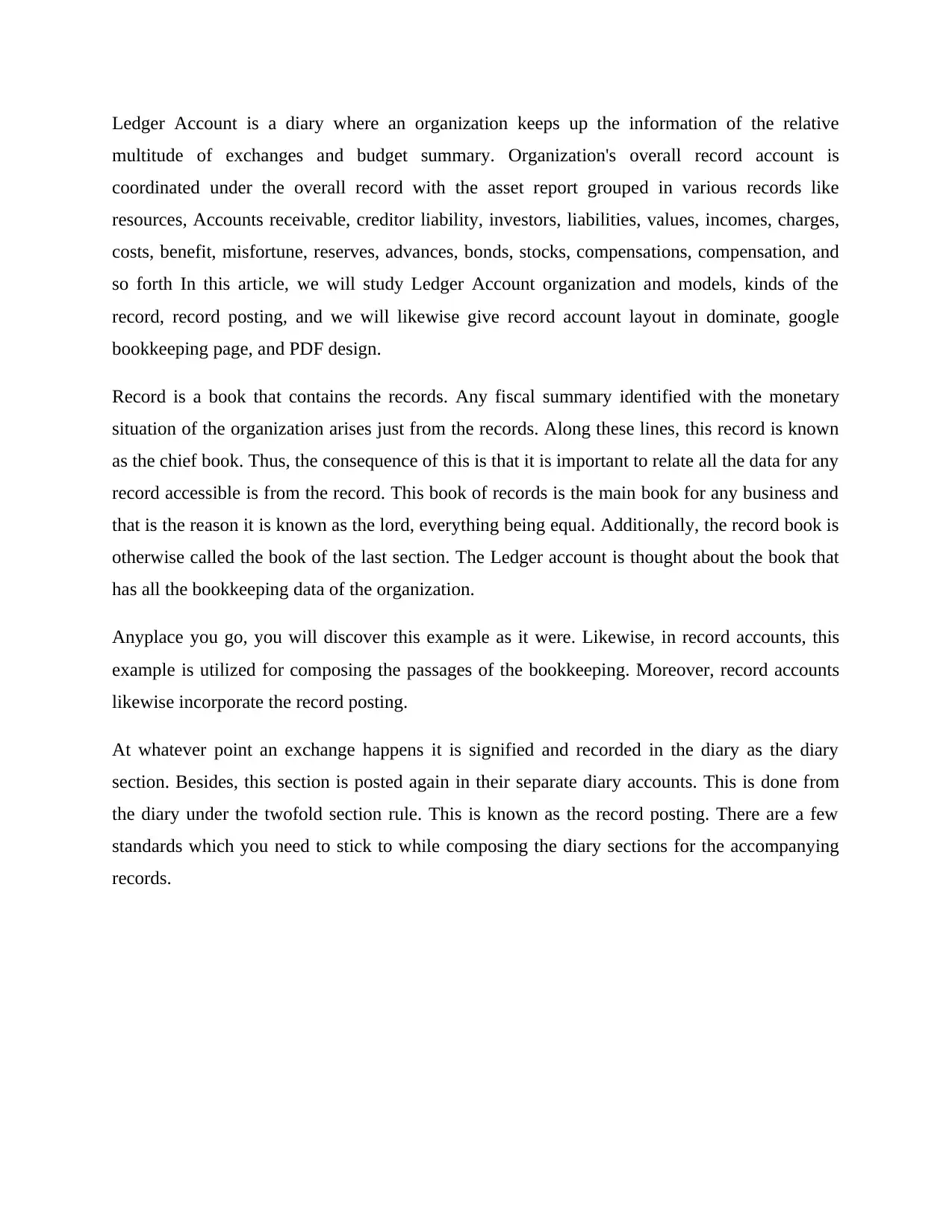
Ledger Account is a diary where an organization keeps up the information of the relative
multitude of exchanges and budget summary. Organization's overall record account is
coordinated under the overall record with the asset report grouped in various records like
resources, Accounts receivable, creditor liability, investors, liabilities, values, incomes, charges,
costs, benefit, misfortune, reserves, advances, bonds, stocks, compensations, compensation, and
so forth In this article, we will study Ledger Account organization and models, kinds of the
record, record posting, and we will likewise give record account layout in dominate, google
bookkeeping page, and PDF design.
Record is a book that contains the records. Any fiscal summary identified with the monetary
situation of the organization arises just from the records. Along these lines, this record is known
as the chief book. Thus, the consequence of this is that it is important to relate all the data for any
record accessible is from the record. This book of records is the main book for any business and
that is the reason it is known as the lord, everything being equal. Additionally, the record book is
otherwise called the book of the last section. The Ledger account is thought about the book that
has all the bookkeeping data of the organization.
Anyplace you go, you will discover this example as it were. Likewise, in record accounts, this
example is utilized for composing the passages of the bookkeeping. Moreover, record accounts
likewise incorporate the record posting.
At whatever point an exchange happens it is signified and recorded in the diary as the diary
section. Besides, this section is posted again in their separate diary accounts. This is done from
the diary under the twofold section rule. This is known as the record posting. There are a few
standards which you need to stick to while composing the diary sections for the accompanying
records.
multitude of exchanges and budget summary. Organization's overall record account is
coordinated under the overall record with the asset report grouped in various records like
resources, Accounts receivable, creditor liability, investors, liabilities, values, incomes, charges,
costs, benefit, misfortune, reserves, advances, bonds, stocks, compensations, compensation, and
so forth In this article, we will study Ledger Account organization and models, kinds of the
record, record posting, and we will likewise give record account layout in dominate, google
bookkeeping page, and PDF design.
Record is a book that contains the records. Any fiscal summary identified with the monetary
situation of the organization arises just from the records. Along these lines, this record is known
as the chief book. Thus, the consequence of this is that it is important to relate all the data for any
record accessible is from the record. This book of records is the main book for any business and
that is the reason it is known as the lord, everything being equal. Additionally, the record book is
otherwise called the book of the last section. The Ledger account is thought about the book that
has all the bookkeeping data of the organization.
Anyplace you go, you will discover this example as it were. Likewise, in record accounts, this
example is utilized for composing the passages of the bookkeeping. Moreover, record accounts
likewise incorporate the record posting.
At whatever point an exchange happens it is signified and recorded in the diary as the diary
section. Besides, this section is posted again in their separate diary accounts. This is done from
the diary under the twofold section rule. This is known as the record posting. There are a few
standards which you need to stick to while composing the diary sections for the accompanying
records.
⊘ This is a preview!⊘
Do you want full access?
Subscribe today to unlock all pages.

Trusted by 1+ million students worldwide
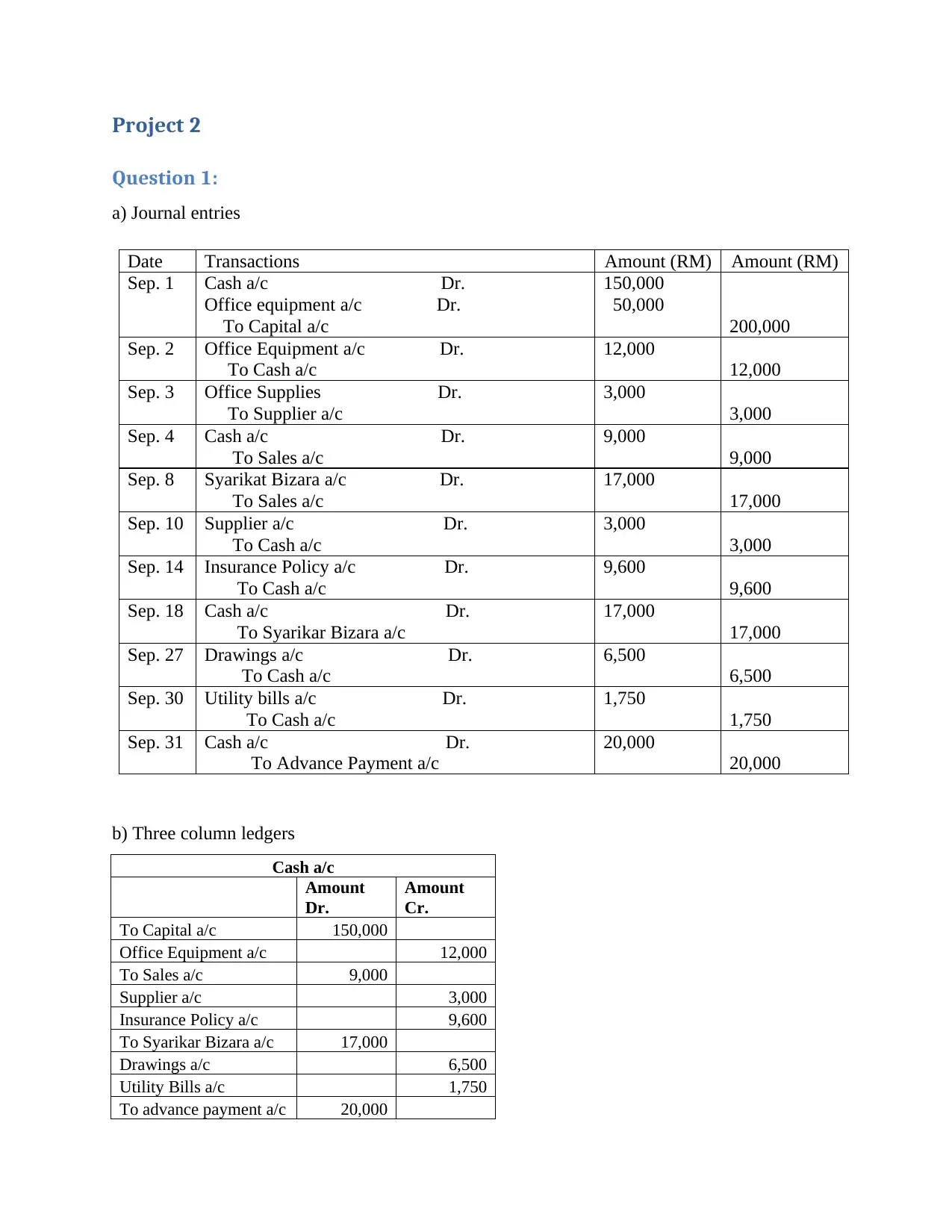
Project 2
Question 1:
a) Journal entries
Date Transactions Amount (RM) Amount (RM)
Sep. 1 Cash a/c Dr.
Office equipment a/c Dr.
To Capital a/c
150,000
50,000
200,000
Sep. 2 Office Equipment a/c Dr.
To Cash a/c
12,000
12,000
Sep. 3 Office Supplies Dr.
To Supplier a/c
3,000
3,000
Sep. 4 Cash a/c Dr.
To Sales a/c
9,000
9,000
Sep. 8 Syarikat Bizara a/c Dr.
To Sales a/c
17,000
17,000
Sep. 10 Supplier a/c Dr.
To Cash a/c
3,000
3,000
Sep. 14 Insurance Policy a/c Dr.
To Cash a/c
9,600
9,600
Sep. 18 Cash a/c Dr.
To Syarikar Bizara a/c
17,000
17,000
Sep. 27 Drawings a/c Dr.
To Cash a/c
6,500
6,500
Sep. 30 Utility bills a/c Dr.
To Cash a/c
1,750
1,750
Sep. 31 Cash a/c Dr.
To Advance Payment a/c
20,000
20,000
b) Three column ledgers
Cash a/c
Amount
Dr.
Amount
Cr.
To Capital a/c 150,000
Office Equipment a/c 12,000
To Sales a/c 9,000
Supplier a/c 3,000
Insurance Policy a/c 9,600
To Syarikar Bizara a/c 17,000
Drawings a/c 6,500
Utility Bills a/c 1,750
To advance payment a/c 20,000
Question 1:
a) Journal entries
Date Transactions Amount (RM) Amount (RM)
Sep. 1 Cash a/c Dr.
Office equipment a/c Dr.
To Capital a/c
150,000
50,000
200,000
Sep. 2 Office Equipment a/c Dr.
To Cash a/c
12,000
12,000
Sep. 3 Office Supplies Dr.
To Supplier a/c
3,000
3,000
Sep. 4 Cash a/c Dr.
To Sales a/c
9,000
9,000
Sep. 8 Syarikat Bizara a/c Dr.
To Sales a/c
17,000
17,000
Sep. 10 Supplier a/c Dr.
To Cash a/c
3,000
3,000
Sep. 14 Insurance Policy a/c Dr.
To Cash a/c
9,600
9,600
Sep. 18 Cash a/c Dr.
To Syarikar Bizara a/c
17,000
17,000
Sep. 27 Drawings a/c Dr.
To Cash a/c
6,500
6,500
Sep. 30 Utility bills a/c Dr.
To Cash a/c
1,750
1,750
Sep. 31 Cash a/c Dr.
To Advance Payment a/c
20,000
20,000
b) Three column ledgers
Cash a/c
Amount
Dr.
Amount
Cr.
To Capital a/c 150,000
Office Equipment a/c 12,000
To Sales a/c 9,000
Supplier a/c 3,000
Insurance Policy a/c 9,600
To Syarikar Bizara a/c 17,000
Drawings a/c 6,500
Utility Bills a/c 1,750
To advance payment a/c 20,000
Paraphrase This Document
Need a fresh take? Get an instant paraphrase of this document with our AI Paraphraser
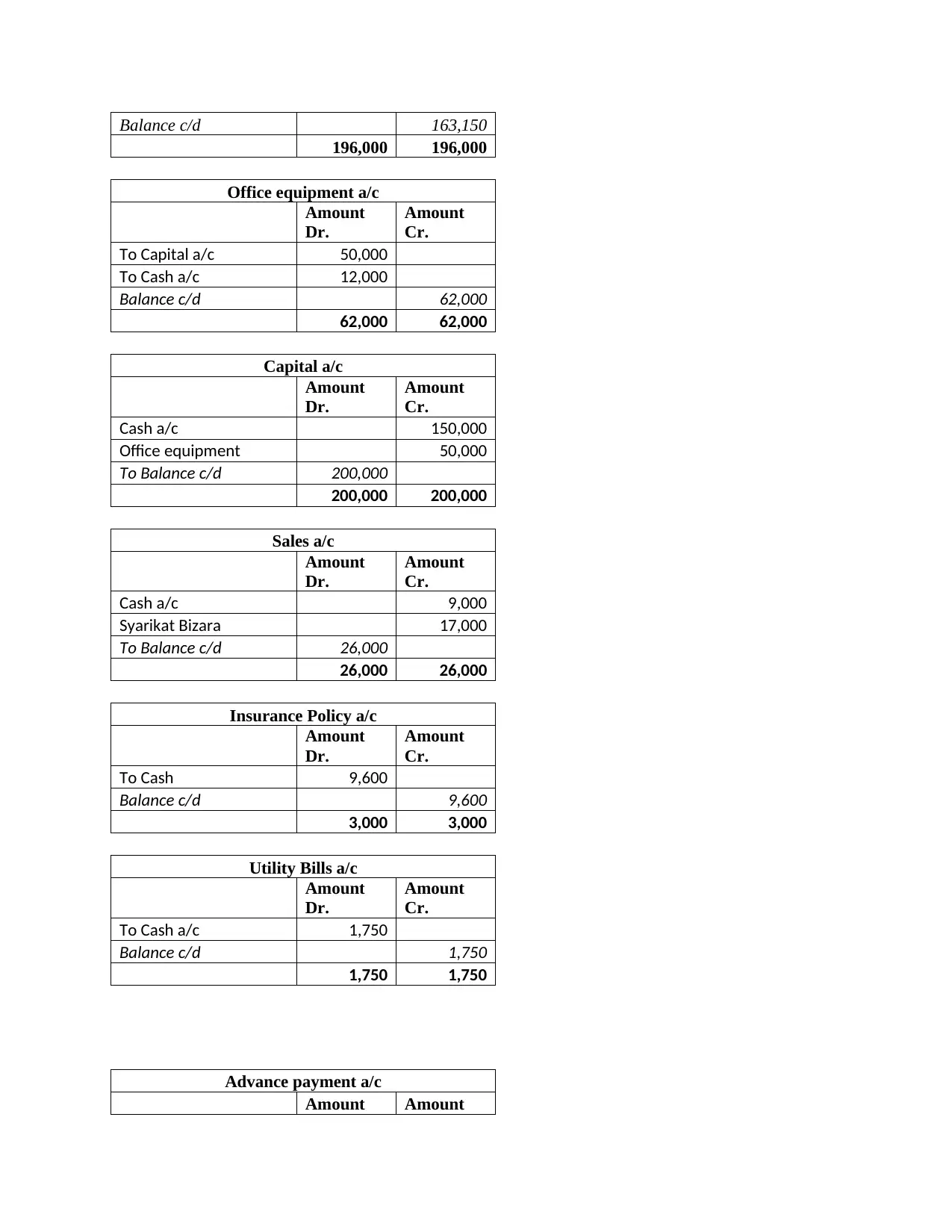
Balance c/d 163,150
196,000 196,000
Office equipment a/c
Amount
Dr.
Amount
Cr.
To Capital a/c 50,000
To Cash a/c 12,000
Balance c/d 62,000
62,000 62,000
Capital a/c
Amount
Dr.
Amount
Cr.
Cash a/c 150,000
Office equipment 50,000
To Balance c/d 200,000
200,000 200,000
Sales a/c
Amount
Dr.
Amount
Cr.
Cash a/c 9,000
Syarikat Bizara 17,000
To Balance c/d 26,000
26,000 26,000
Insurance Policy a/c
Amount
Dr.
Amount
Cr.
To Cash 9,600
Balance c/d 9,600
3,000 3,000
Utility Bills a/c
Amount
Dr.
Amount
Cr.
To Cash a/c 1,750
Balance c/d 1,750
1,750 1,750
Advance payment a/c
Amount Amount
196,000 196,000
Office equipment a/c
Amount
Dr.
Amount
Cr.
To Capital a/c 50,000
To Cash a/c 12,000
Balance c/d 62,000
62,000 62,000
Capital a/c
Amount
Dr.
Amount
Cr.
Cash a/c 150,000
Office equipment 50,000
To Balance c/d 200,000
200,000 200,000
Sales a/c
Amount
Dr.
Amount
Cr.
Cash a/c 9,000
Syarikat Bizara 17,000
To Balance c/d 26,000
26,000 26,000
Insurance Policy a/c
Amount
Dr.
Amount
Cr.
To Cash 9,600
Balance c/d 9,600
3,000 3,000
Utility Bills a/c
Amount
Dr.
Amount
Cr.
To Cash a/c 1,750
Balance c/d 1,750
1,750 1,750
Advance payment a/c
Amount Amount
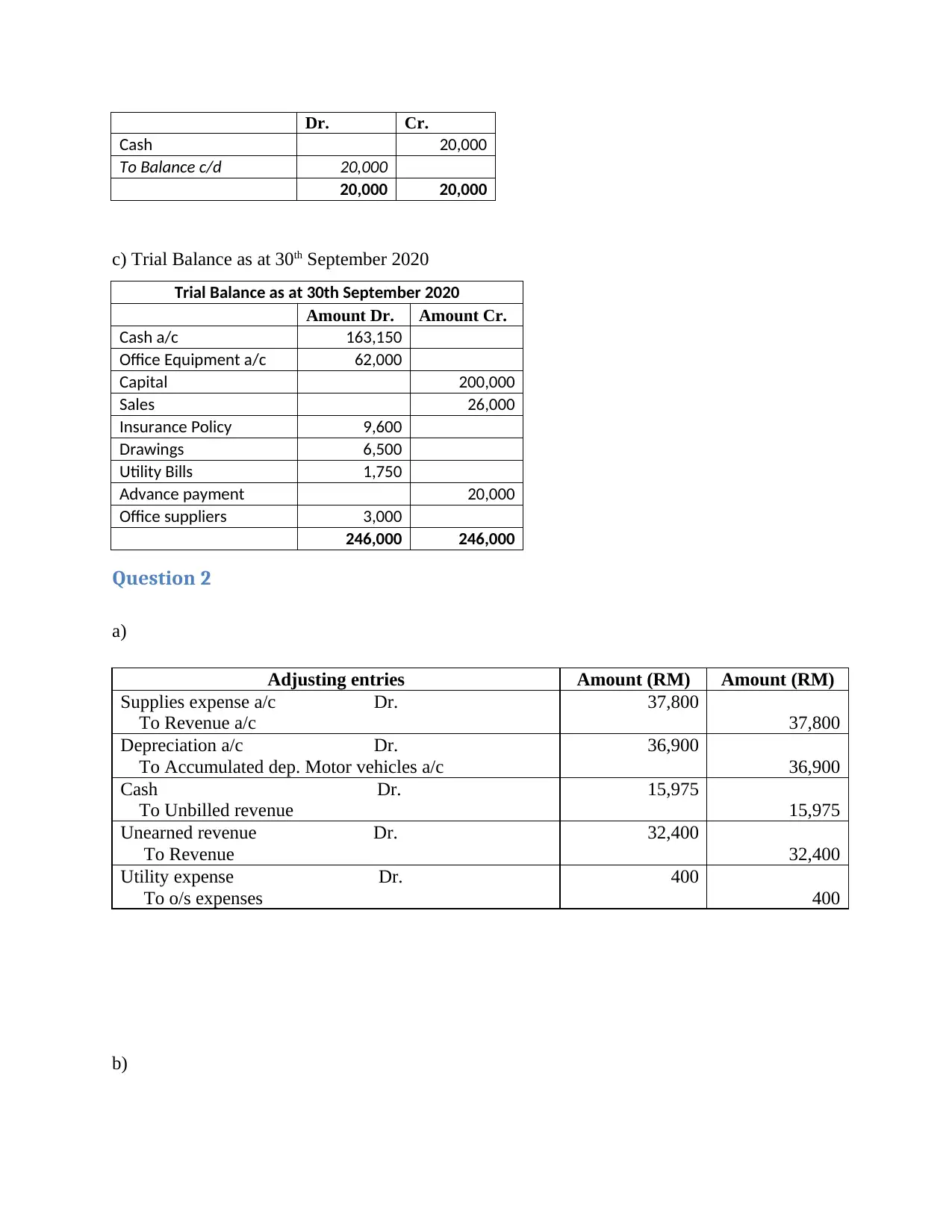
Dr. Cr.
Cash 20,000
To Balance c/d 20,000
20,000 20,000
c) Trial Balance as at 30th September 2020
Trial Balance as at 30th September 2020
Amount Dr. Amount Cr.
Cash a/c 163,150
Office Equipment a/c 62,000
Capital 200,000
Sales 26,000
Insurance Policy 9,600
Drawings 6,500
Utility Bills 1,750
Advance payment 20,000
Office suppliers 3,000
246,000 246,000
Question 2
a)
Adjusting entries Amount (RM) Amount (RM)
Supplies expense a/c Dr.
To Revenue a/c
37,800
37,800
Depreciation a/c Dr.
To Accumulated dep. Motor vehicles a/c
36,900
36,900
Cash Dr.
To Unbilled revenue
15,975
15,975
Unearned revenue Dr.
To Revenue
32,400
32,400
Utility expense Dr.
To o/s expenses
400
400
b)
Cash 20,000
To Balance c/d 20,000
20,000 20,000
c) Trial Balance as at 30th September 2020
Trial Balance as at 30th September 2020
Amount Dr. Amount Cr.
Cash a/c 163,150
Office Equipment a/c 62,000
Capital 200,000
Sales 26,000
Insurance Policy 9,600
Drawings 6,500
Utility Bills 1,750
Advance payment 20,000
Office suppliers 3,000
246,000 246,000
Question 2
a)
Adjusting entries Amount (RM) Amount (RM)
Supplies expense a/c Dr.
To Revenue a/c
37,800
37,800
Depreciation a/c Dr.
To Accumulated dep. Motor vehicles a/c
36,900
36,900
Cash Dr.
To Unbilled revenue
15,975
15,975
Unearned revenue Dr.
To Revenue
32,400
32,400
Utility expense Dr.
To o/s expenses
400
400
b)
⊘ This is a preview!⊘
Do you want full access?
Subscribe today to unlock all pages.

Trusted by 1+ million students worldwide
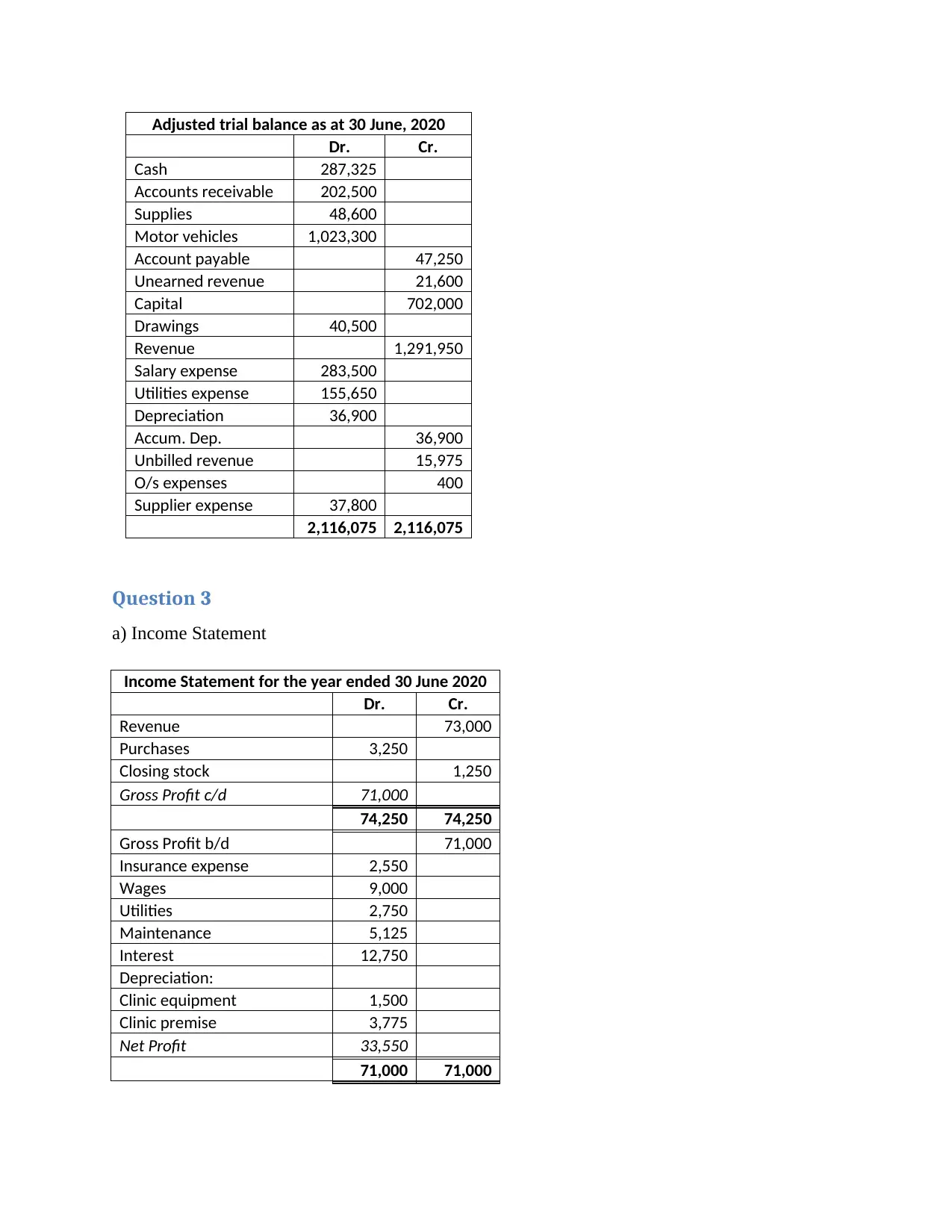
Adjusted trial balance as at 30 June, 2020
Dr. Cr.
Cash 287,325
Accounts receivable 202,500
Supplies 48,600
Motor vehicles 1,023,300
Account payable 47,250
Unearned revenue 21,600
Capital 702,000
Drawings 40,500
Revenue 1,291,950
Salary expense 283,500
Utilities expense 155,650
Depreciation 36,900
Accum. Dep. 36,900
Unbilled revenue 15,975
O/s expenses 400
Supplier expense 37,800
2,116,075 2,116,075
Question 3
a) Income Statement
Income Statement for the year ended 30 June 2020
Dr. Cr.
Revenue 73,000
Purchases 3,250
Closing stock 1,250
Gross Profit c/d 71,000
74,250 74,250
Gross Profit b/d 71,000
Insurance expense 2,550
Wages 9,000
Utilities 2,750
Maintenance 5,125
Interest 12,750
Depreciation:
Clinic equipment 1,500
Clinic premise 3,775
Net Profit 33,550
71,000 71,000
Dr. Cr.
Cash 287,325
Accounts receivable 202,500
Supplies 48,600
Motor vehicles 1,023,300
Account payable 47,250
Unearned revenue 21,600
Capital 702,000
Drawings 40,500
Revenue 1,291,950
Salary expense 283,500
Utilities expense 155,650
Depreciation 36,900
Accum. Dep. 36,900
Unbilled revenue 15,975
O/s expenses 400
Supplier expense 37,800
2,116,075 2,116,075
Question 3
a) Income Statement
Income Statement for the year ended 30 June 2020
Dr. Cr.
Revenue 73,000
Purchases 3,250
Closing stock 1,250
Gross Profit c/d 71,000
74,250 74,250
Gross Profit b/d 71,000
Insurance expense 2,550
Wages 9,000
Utilities 2,750
Maintenance 5,125
Interest 12,750
Depreciation:
Clinic equipment 1,500
Clinic premise 3,775
Net Profit 33,550
71,000 71,000
Paraphrase This Document
Need a fresh take? Get an instant paraphrase of this document with our AI Paraphraser
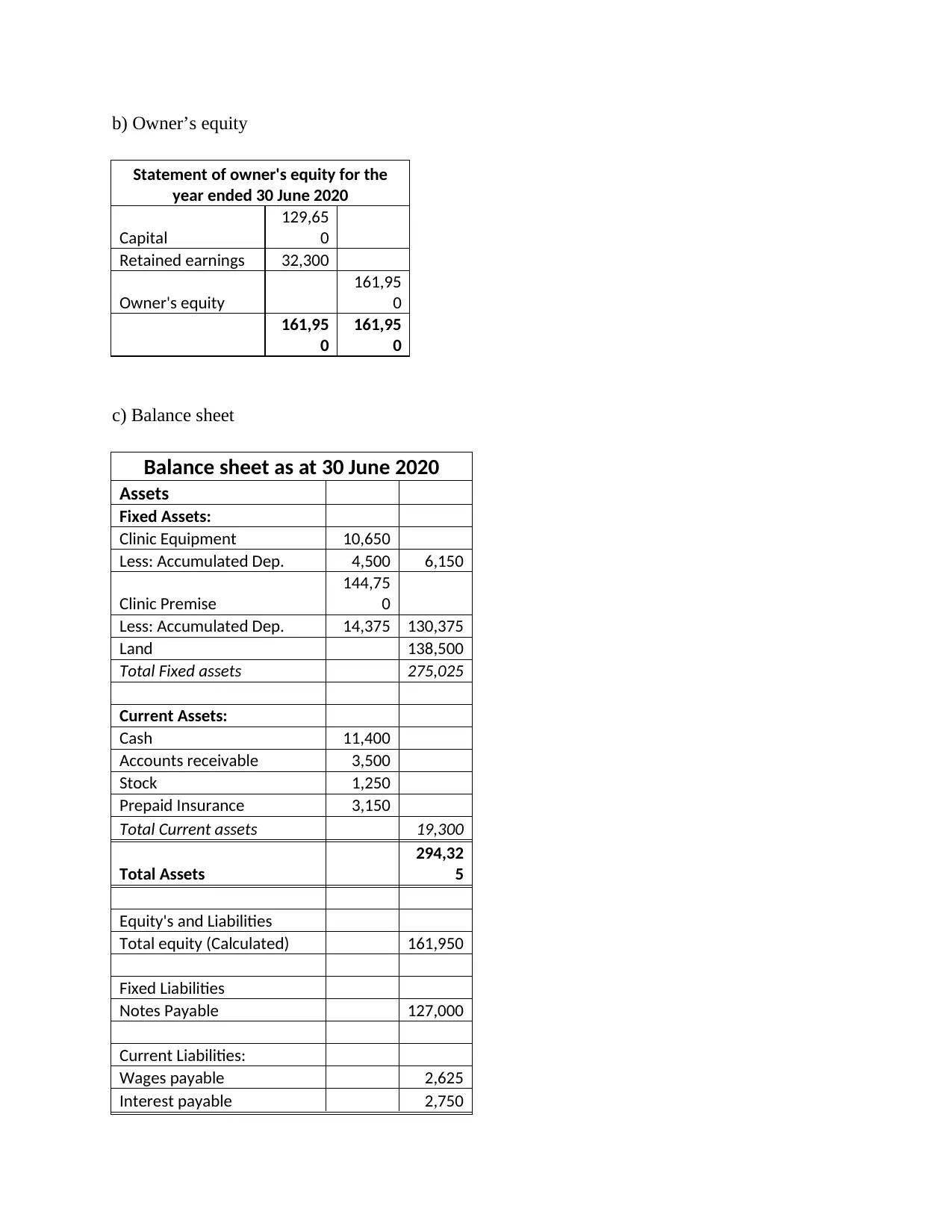
b) Owner’s equity
Statement of owner's equity for the
year ended 30 June 2020
Capital
129,65
0
Retained earnings 32,300
Owner's equity
161,95
0
161,95
0
161,95
0
c) Balance sheet
Balance sheet as at 30 June 2020
Assets
Fixed Assets:
Clinic Equipment 10,650
Less: Accumulated Dep. 4,500 6,150
Clinic Premise
144,75
0
Less: Accumulated Dep. 14,375 130,375
Land 138,500
Total Fixed assets 275,025
Current Assets:
Cash 11,400
Accounts receivable 3,500
Stock 1,250
Prepaid Insurance 3,150
Total Current assets 19,300
Total Assets
294,32
5
Equity's and Liabilities
Total equity (Calculated) 161,950
Fixed Liabilities
Notes Payable 127,000
Current Liabilities:
Wages payable 2,625
Interest payable 2,750
Statement of owner's equity for the
year ended 30 June 2020
Capital
129,65
0
Retained earnings 32,300
Owner's equity
161,95
0
161,95
0
161,95
0
c) Balance sheet
Balance sheet as at 30 June 2020
Assets
Fixed Assets:
Clinic Equipment 10,650
Less: Accumulated Dep. 4,500 6,150
Clinic Premise
144,75
0
Less: Accumulated Dep. 14,375 130,375
Land 138,500
Total Fixed assets 275,025
Current Assets:
Cash 11,400
Accounts receivable 3,500
Stock 1,250
Prepaid Insurance 3,150
Total Current assets 19,300
Total Assets
294,32
5
Equity's and Liabilities
Total equity (Calculated) 161,950
Fixed Liabilities
Notes Payable 127,000
Current Liabilities:
Wages payable 2,625
Interest payable 2,750
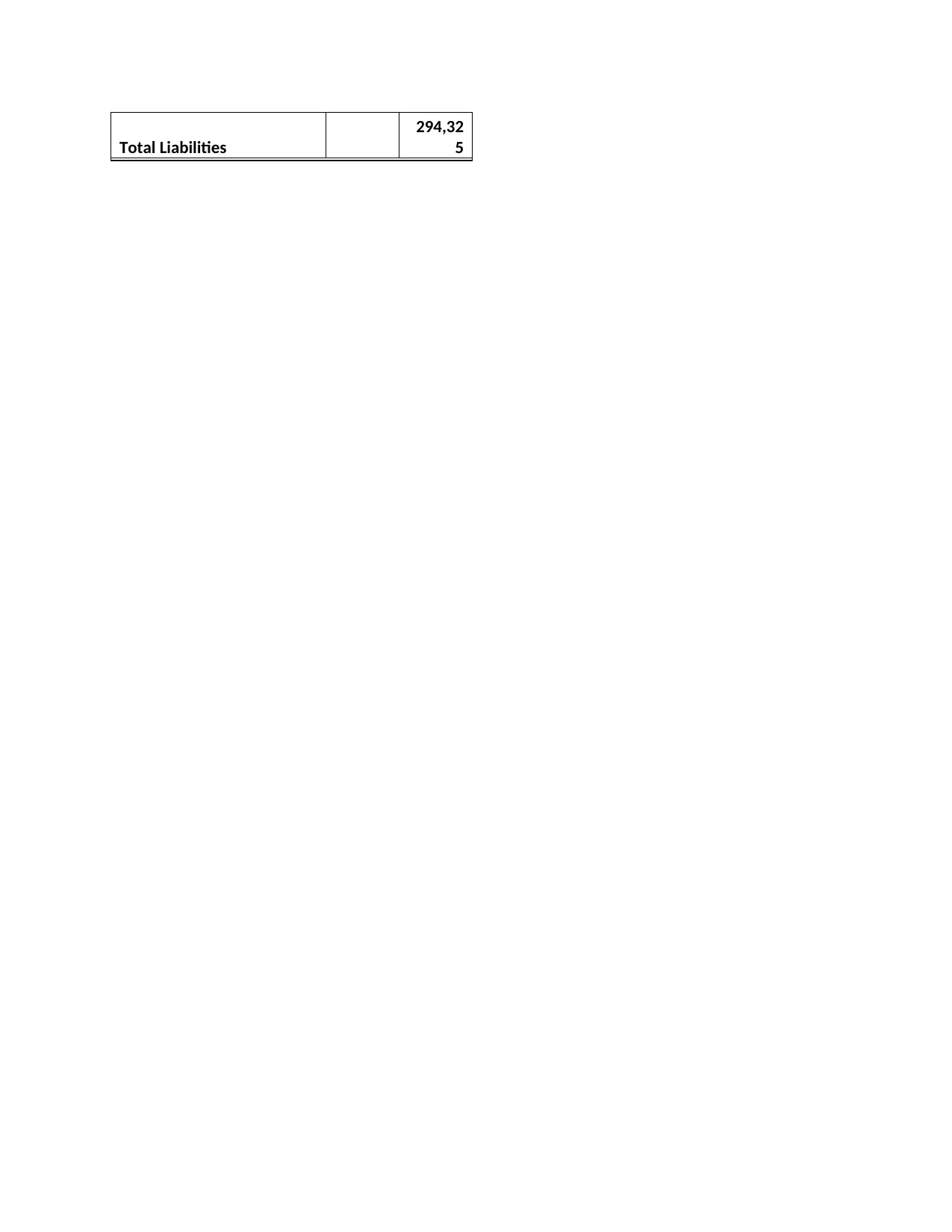
Total Liabilities
294,32
5
294,32
5
⊘ This is a preview!⊘
Do you want full access?
Subscribe today to unlock all pages.

Trusted by 1+ million students worldwide
1 out of 13
Related Documents
Your All-in-One AI-Powered Toolkit for Academic Success.
+13062052269
info@desklib.com
Available 24*7 on WhatsApp / Email
![[object Object]](/_next/static/media/star-bottom.7253800d.svg)
Unlock your academic potential
Copyright © 2020–2025 A2Z Services. All Rights Reserved. Developed and managed by ZUCOL.





